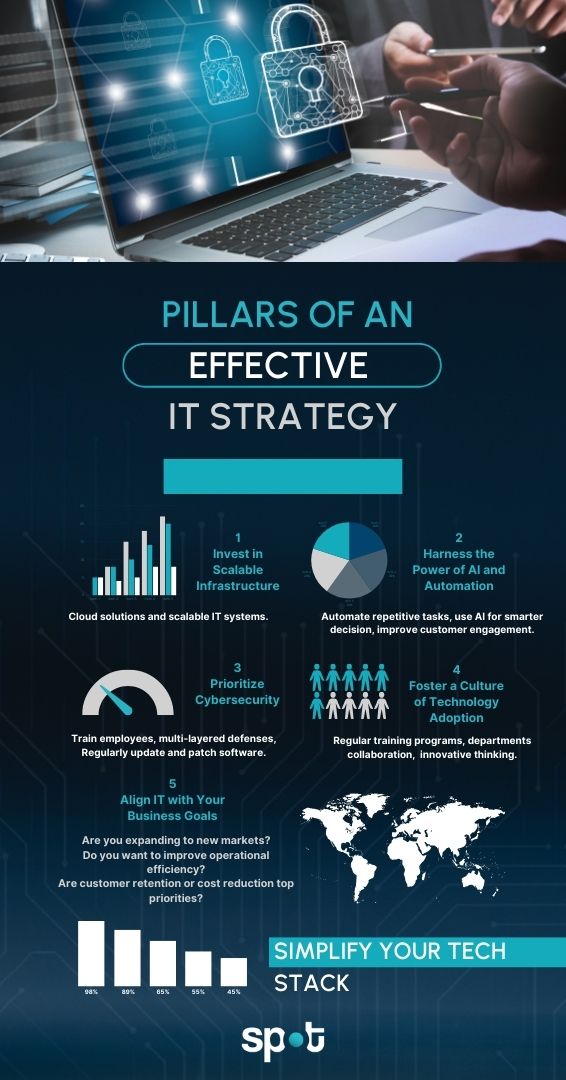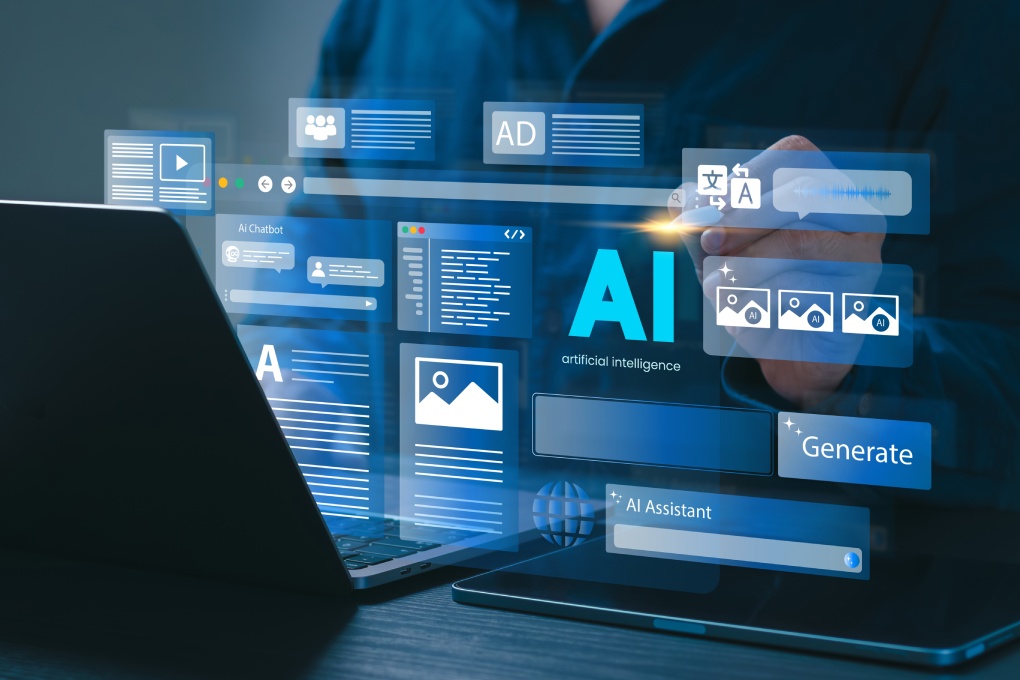2025 IT Strategy Planning Guide for Businesses
How to Leverage Technology for Growth, Agility, and Security.
As we approach 2025, small and midsize businesses (SMBs) stand on the edge of a transformative era. Technology is no longer just a tool—it’s the foundation of growth, innovation, and resilience. For SMBs looking to thrive in a highly competitive market, a forward-thinking IT strategy is essential.
This guide will help you craft a winning IT strategy for 2025. From navigating the latest trends to implementing practical solutions, we’ll explore how your business can unlock its full potential.
Why an IT Strategy Matters
Gone are the days when IT was seen as a cost center. Today, IT is a growth engine driving efficiency, customer satisfaction, and innovation. A robust IT strategy helps businesses:
- Boost Efficiency: Automate processes, integrate systems, and cut costs.
- Deliver Exceptional Customer Experiences: Use technology to provide faster, personalized service.
- Strengthen Security: Stay ahead of growing cyber threats.
- Scale Seamlessly: Build a foundation that adapts as your business grows.
The time to act is now. As we explore key components of an IT strategy, you’ll see how the right investments can future-proof your business.
Pillars of an Effective IT Strategy

1. Align IT with Your Business Goals
An IT strategy without alignment to your business objectives is like setting sail without a map. Start by asking:
- Are you expanding to new markets?
- Do you want to improve operational efficiency?
- Are customer retention or cost reduction top priorities?
Define your business goals first, then design your IT roadmap to meet them.
2. Harness the Power of AI and Automation
Artificial Intelligence (AI) and automation are reshaping industries. These tools are no longer reserved for large enterprises—they’re accessible and critical for SMBs.
- Automate repetitive tasks to free up your team for strategic initiatives.
- Use AI for smarter decision-making with predictive analytics.
- Improve customer engagement with chatbots and AI-driven insights.
3. Simplify Your Tech Stack
Many SMBs struggle with outdated or disconnected tools. A cluttered tech stack can lead to inefficiencies and higher costs. Simplify by:
- Investing in integrated platforms to eliminate redundancy.
- Ensuring seamless interoperability between tools and systems.
4. Prioritize Cybersecurity
In 2025, cybersecurity will remain a top concern. Cybercriminals are becoming more sophisticated, and SMBs are frequent targets.
- Train employees to recognize phishing and other common threats.
- Implement multi-layered defenses, including firewalls and encryption.
- Regularly update and patch software to close vulnerabilities.
5. Invest in Scalable Infrastructure
As your business grows, your technology needs to grow with it. Scalability ensures that you can meet increased demand without costly overhauls.
- Cloud solutions offer flexibility and cost efficiency.
- Scalable IT systems prepare you for both steady growth and unexpected surges.
A strong infrastructure is the backbone of a thriving business.
6. Foster a Culture of Technology Adoption
Even the best tools are useless if your team isn’t equipped to use them. Build a tech-driven culture by:
- Offering regular training programs to keep employees up-to-date.
- Promoting collaboration between IT and other departments.
- Encouraging innovative thinking at all levels of your organization.
Your people are your most valuable asset—empower them to leverage technology effectively.
Enhancing Your IT Strategy Planning with Comprehensive Services

When crafting an IT strategy that empowers your business, incorporating a wide range of services ensures a robust, scalable, and secure technology framework. Below are critical components to add to your IT strategy for a well-rounded approach:
Cybersecurity and Cybersecurity Insurance Advisory
Safeguarding sensitive business data is essential. Implementing strong cybersecurity measures, such as firewalls, encryption, and multi-factor authentication, is just the beginning. Pair this with cybersecurity insurance advisory to mitigate potential financial risks from breaches, ensuring your business is protected on all fronts.
Data Backup Solutions
A comprehensive data backup strategy safeguards your operations against data loss due to hardware failures, cyberattacks, or natural disasters. Cloud-based and on-premises solutions ensure quick recovery and continuity for your business.
VOIP Phone Systems
Modern communication solutions, like Voice Over Internet Protocol (VOIP) phone systems, offer cost-effective and flexible alternatives to traditional telephony. They integrate seamlessly with other business tools and provide features like video conferencing, call forwarding, and voicemail-to-email.
Security Cameras and Wiring Infrastructure
Physical security complements your digital defenses. Installing high-definition security cameras and implementing efficient wiring infrastructure not only protects your assets but also enhances surveillance and connectivity across your premises.
Business Reporting
Data-driven decision-making is crucial for a successful IT strategy. Leverage advanced reporting tools to analyze performance metrics, track trends, and make informed decisions to drive your business forward.
Employee Security Training
Human error is a leading cause of cybersecurity incidents. Equip your team with the knowledge and skills to recognize phishing attempts, use secure passwords, and adhere to best practices through regular security training programs.
Risk Assessment
Conducting regular IT risk assessments helps identify vulnerabilities, evaluate the effectiveness of current measures, and prioritize future investments in technology. Proactive assessments ensure your IT strategy stays aligned with business goals and evolving threats.
By integrating these services into your IT strategy planning guide, your business can build a resilient technology infrastructure, safeguard sensitive information, and empower your team to achieve long-term success.
Emerging Trends to Watch in 2025

AI Will Become Mainstream
AI adoption will accelerate, with SMBs leveraging it to uncover customer insights, optimize operations, and stay competitive.
Hybrid Work Models Are Here to Stay
Remote and hybrid work setups will continue to shape how businesses operate. Ensure your IT strategy includes tools for seamless collaboration, secure remote access, and productivity tracking.
Sustainability in IT
Green IT practices—such as energy-efficient technologies and sustainable data management—are gaining traction. Not only are they environmentally friendly, but they can also improve cost-efficiency.
Your 12-Month Action Plan for IT Excellence

To help you implement your IT strategy, here’s a simple roadmap:
-
Q1: Assess and Plan
- Conduct a technology audit.
- Identify gaps and opportunities in your current systems.
- Set measurable objectives for your IT strategy.
-
Q2: Implement Key Upgrades
- Start foundational improvements like cloud migration or cybersecurity enhancements.
- Launch employee training programs.
-
Q3: Optimize Operations
- Refine your tech stack for maximum efficiency.
- Use performance metrics to track success and address issues.
-
Q4: Prepare to Scale
- Introduce advanced technologies like AI and IoT.
- Ensure your infrastructure is ready for future growth.
Partner with Spot On Tech for Success
Building an effective IT strategy is challenging—but you don’t have to do it alone. At Spot On Tech, we empower SMBs with tailored solutions to meet their unique needs.
- Schedule a Free Consultation to start planning your IT transformation.
Exclusive Offer: Free eBook
Want to dive deeper? Download our free eBook: “Scaling Your Business in 2025: Threats, Challenges, and Opportunities.” It’s packed with actionable insights to help your business navigate the road ahead.
2025 is full of promise. With the right IT strategy, your business can overcome challenges, seize opportunities, and achieve sustainable growth. The future belongs to those who plan for it—let’s start building yours today.




